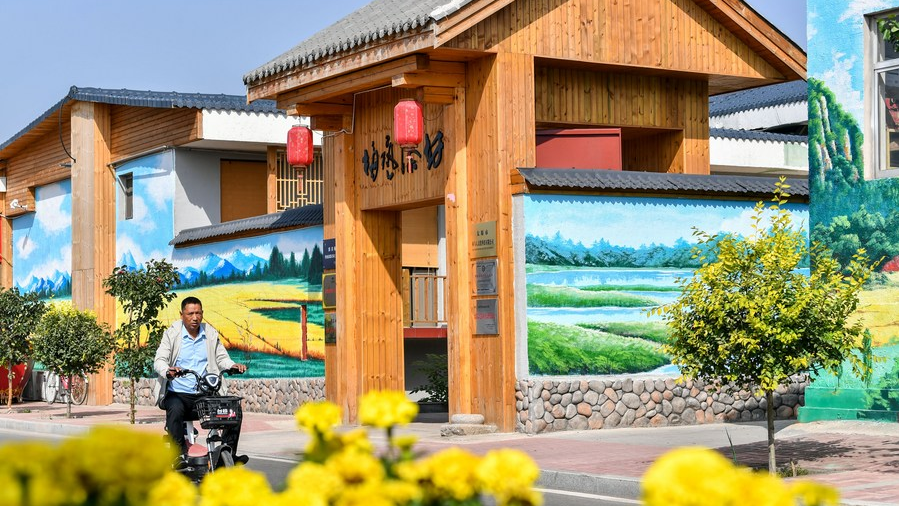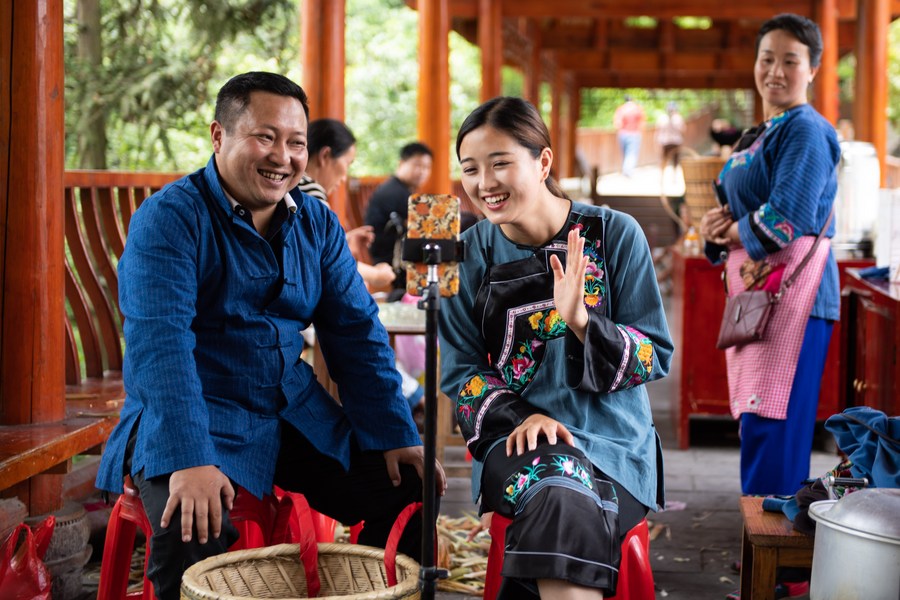
A view of Liujiabao Village in Taiyuan, north China's Shanxi Province, October 1, 2021. /Xinhua
A view of Liujiabao Village in Taiyuan, north China's Shanxi Province, October 1, 2021. /Xinhua
Chinese modernization is the improvement of lives of a huge population as it is working to achieve modernization for more than 1.4 billion people. This is a task unparalleled in difficulty and complexity; it inevitably means that the country's pathways of development and methods of advancement will be unique, according to a report to the 20th National Congress of the Communist Party of China (CPC).
It is the modernization of common prosperity for all, the immutable goal of the Chinese modernization drive is to meet the people's aspirations for a better life, said the report, noting that China has worked continuously to ensure people's access to childcare, education, employment, medical services, elderly care, housing, and social assistance, bringing about an all-around improvement in people's lives,
What has country done to achieve the modernization and why can the modernization drive help its people lead better lives?
Poverty alleviation
By the end of 2020, the final 98.99 million impoverished rural residents in China had all been lifted out of poverty, and all 832 impoverished counties and 128,000 villages had been removed from the poverty list.
During its poverty alleviation practices, China has developed a set of standards and procedures to accurately identify the poor, and grassroots officials have spent time in villages analyzing the distribution of the poor population, the causes of their poverty, and their needs, according to the white paper titled "Poverty Alleviation: China's Experience and Contribution."
For instance, poor households are identified primarily based on their incomes, with consideration given to factors such as housing, education and health. Household applications for poverty registration are discussed and reviewed, disclosed for public supervision, and then evaluated by each level of administration.
For administrative villages applying to be registered, consideration is given to the incidence of poverty, the net per capita income of the villagers, and income from businesses run by village collectives.
Through its registration system, China has identified every poor individual in every village, every poor household has the causes of their poverty and their needs registered with the government, it said.
"The strategy of targeted poverty alleviation is China's strongest weapon in its final battle to secure victory against poverty, and a major innovation in the theory and practice of poverty alleviation," the white paper said.
After declaring the eradication of absolute poverty in early 2021, China has pledged to consolidate poverty alleviation achievements to prevent a mass return to poverty and a number of measures were rolled out to consolidate the achievements in poverty eradication.
For instance, a dynamic monitoring and support mechanism to prevent the once poor population from falling back into poverty was established. And in 2011, the central government allocated 156.1 billion yuan ($24.5 billion) in subsidies to promote rural vitalization, an increase of 10 billion yuan over the previous year according to the National Rural Revitalization Administration.

Ma Huihuang (L), then head of the poverty alleviation work team in Shibadong, promotes local products via live-streaming in Shibadong Village of Xiangxi Tujia and Miao Autonomous Prefecture, central China's Hunan Province, May 15, 2020. /Xinhua
Ma Huihuang (L), then head of the poverty alleviation work team in Shibadong, promotes local products via live-streaming in Shibadong Village of Xiangxi Tujia and Miao Autonomous Prefecture, central China's Hunan Province, May 15, 2020. /Xinhua
Rural revitalization
In recent years, various localities have focused on revitalizing industries according to local conditions, cultivating and developing new rural industries and new formats. By the end of 2022, 40 industrial clusters with distinctive features and 50 national modern agricultural industrial parks were built, along with 200 agricultural towns.
Besides, from the development of saline-alkali land for the construction of high-standard farmland, China continues to consolidate the foundation of food security. By the end of 2022, China built a total of 1 billion mu (66.7 million hectares) of high-standard farmland. In 2023, 45 million mu will be built and 35 million mu will be upgraded.
Since 2014, China has witnessed rapid development in rural e-commerce, driven by the country's increased support for this sector. China's rural internet users exceeded 300 million, and online retail sales in rural areas surged from 180 billion yuan in 2014 to 2.17 trillion yuan in 2022, according to the Ministry of Agriculture and Rural Affairs.
The "No. 1 central document" for 2023, released this February, outlined nine tasks, from ensuring grain supply and bolstering high-quality rural industries to increasing farmers' incomes and developing a beautiful countryside.
China will strive to ensure that more than 60 percent of central government subsidies for rural revitalization are used to develop local industries, and that there will be stable employment for more than 30 million people, it said.
So far, China has built the largest education, social security, and healthcare systems in the world. Its per capita disposable annual income has risen from 16,500 yuan to 35,100 yuan, and more than 13 million urban jobs have been created each year on average over the past 10 years, according to the report to the 20th CPC National Congress.
Nearly 1.06 billion people have been covered by basic pension insurance, with basic medical insurance for 95 percent of the population, according to the Human Resources and Social Security.
China, on its way toward modernization, has also been sharing its development dividends with the rest of the world as modernization of the more than 1.4 billion Chinese people will create a market rivaling the aggregated size of all developed countries, said a white paper on building a global community of shared future issued on Tuesday.
Take the Belt and Road Initiative (BRI) as an example. According to a World Bank forecast, if all Belt and Road transport infrastructure projects are carried out, the initiative would generate $1.6 trillion of global revenues annually to 2030. Up to 90 percent of the revenues would go to partner countries.